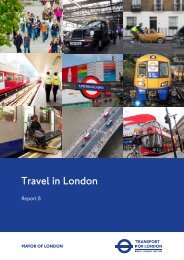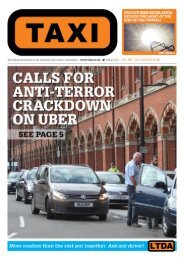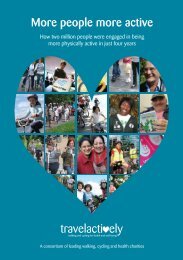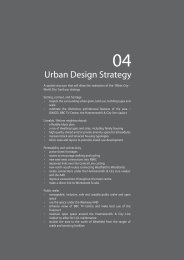Male-and-female-employment2012.pdf
Male-and-female-employment2012.pdf
Male-and-female-employment2012.pdf
Create successful ePaper yourself
Turn your PDF publications into a flip-book with our unique Google optimized e-Paper software.
<strong>Male</strong> <strong>and</strong> <strong>female</strong> employment in<br />
the passenger transport sector<br />
Contents<br />
<strong>Male</strong> <strong>and</strong> <strong>female</strong> employment page 2<br />
Gender perception of specific occupations page 2<br />
Nature of specific job roles page 3<br />
Implications of current gender imbalance page 4<br />
Case study: Step on the Bus page 6<br />
1
<strong>Male</strong> <strong>and</strong> <strong>female</strong> employment<br />
<strong>Male</strong> <strong>and</strong> <strong>female</strong> employment profile:<br />
• 78 percent of the sector’s workforce is male<br />
• Women only make up 13 per cent of the taxi <strong>and</strong> private hire operation<br />
• The gender split within aviation is much more equal, with 44 per cent women<br />
Whilst overall men dominate the workforce, core occupations in passenger transport are<br />
characterised by large gender imbalances. Possibly the most extreme example is that only 13<br />
percent of those working in taxi <strong>and</strong> private hire operations are women, whilst 79 percent of air<br />
travel assistants are <strong>female</strong>.<br />
The reasons for this mixed picture can largely be explained by two factors: Gender perceptions of<br />
specific occupations <strong>and</strong> the nature of specific job roles (for instance, flexibility of hours <strong>and</strong> safety).<br />
Table: Core occupations dominated by gender<br />
Roles dominated by men<br />
Roles dominated by women<br />
Rail construction <strong>and</strong> maintenance operatives (100%) Air travel assistants (79%)<br />
Aircraft pilots (98%) Air traffic controllers (29%)<br />
Train drivers (96%) Rail travel assistants (27%)<br />
Taxi <strong>and</strong> private hire (94%) Driving instructor (20%)<br />
Bus <strong>and</strong> coach drivers (92%) Air transport operatives (17%)<br />
Source: People 1 st analysis of the Labour Force Survey 2010, Office for National Statistics<br />
Gender perception of specific occupations<br />
Some sector job roles are still largely considered to be either male or <strong>female</strong>, which results in<br />
applicants being biased towards one particular gender.<br />
Of all the passenger transport industries, aviation is the most gender balanced industry, with women<br />
making up 44 percent of the workforce. However, within the sector there are clear gender divisions<br />
across occupations, with engineering, firefighting <strong>and</strong> airside operations employing more men, while<br />
cabin crew <strong>and</strong> roles in travel <strong>and</strong> tourist services are clearly dominated by women. Employers rule<br />
out discrimination, but point at obvious cultural factors <strong>and</strong> at the imbalance of applications for<br />
some roles.<br />
People 1st developed Women 1st, a targeted intervention to promote <strong>female</strong> career progression<br />
<strong>and</strong> the development of women within the hospitality workforce. Following the merger between<br />
People 1 st <strong>and</strong> GoSkills this programme is now being extended <strong>and</strong> tailored to target women<br />
employed in the passenger transport sector.<br />
“I think it’s generally because public transport has always been seen as a male domain. It’s not for<br />
the want of trying. We are happy to take <strong>female</strong> employees in driving, engineering <strong>and</strong> management<br />
roles.”<br />
Mike Morton, Managing Director, Arriva Wales, Bus <strong>and</strong> coach<br />
“It just seems to occur naturally. For example you put out an application form for control room staff<br />
<strong>and</strong> 80 percent of the applicants are women, <strong>and</strong> you put out a driver advert <strong>and</strong> 80 percent are<br />
men. There are no barriers.”<br />
Peter Renwick, General Manager, Premier Car, Taxi <strong>and</strong> private hire<br />
2
Nature of specific job roles<br />
Specific occupations continue to be male dominated because of their characteristics or the tasks<br />
they are required to undertake. Some roles require heavy lifting, such as air ground crew, whilst<br />
others, such as taxi <strong>and</strong> private hire, favour men due to safety considerations.<br />
Managerial positions across the sector are strongly male-dominated. Only 24 percent of managers<br />
across the passenger transport sector are women. This is unsurprising as managers tend to be<br />
recruited by promoting those working in operational roles, <strong>and</strong> these roles are also male dominated.<br />
Across the sector, women generally take on roles that are customer-oriented rather than technical in<br />
nature, except for those who are self-employed in driver training.<br />
“We had five new director posts <strong>and</strong> we employed an executive search company with a remit to give<br />
us the most diverse long list they possibly could. However, they really struggled to get a diverse list<br />
with a mix of <strong>female</strong> <strong>and</strong> male c<strong>and</strong>idates. This perhaps points to the fact that within the industry<br />
generally there are a limited number of non-white males who have got that level of experience, <strong>and</strong><br />
who are prepared to put themselves forward”.<br />
Steve Chatwin, Corporate Services Director, Centro, Transport planning<br />
Figure: Gender breakdown across main occupations in passenger transport<br />
Source: People 1 st analysis of the Labour Force Survey 2010, Office for National Statistics<br />
Table: Proportion of <strong>female</strong> managers across industries<br />
Industry<br />
% of <strong>female</strong>s<br />
Taxi <strong>and</strong> private hire 29%<br />
Aviation 25%<br />
Driver training 25%<br />
Rail 23%<br />
Bus <strong>and</strong> coach 22%<br />
Light rail <strong>and</strong> metro 22%<br />
UK waterways 0%<br />
Source: People 1 st analysis of the Labour Force Survey 2010, Office for National Statistics<br />
3
There have been many initiatives to encourage more women into certain roles, for example by<br />
promoting flexible contracts <strong>and</strong> shifts or introducing programmes that are tailored to a <strong>female</strong><br />
audience such as Step on the Bus (see case study).<br />
Some employers report a gradual shift in attitude, with slightly more <strong>female</strong> drivers entering the<br />
sector than in the past. Low rate of labour turnover in some roles such as skippers, engineers or train<br />
drivers means that change can be slow to take effect.<br />
Table: Proportion of <strong>female</strong> drivers<br />
2007 2008 2009 2010<br />
% change 2007-<br />
2010<br />
Train drivers 2.9%
oardroom composition, <strong>and</strong> business performance indicators such as financial performance <strong>and</strong><br />
shareholder value 1 .<br />
The Catalyst report looked at the performance of Fortune 500 companies <strong>and</strong> ranked them by the<br />
number of <strong>female</strong> board members 2 . It found that the companies with the most <strong>female</strong> board<br />
members outperformed those with the least in all measures. They found that in 2007, for companies<br />
in the top quartile, return on equity was 53 percent higher, return on sales 42 percent higher, <strong>and</strong><br />
return on invested capital 66 percent higher than for the companies in the bottom quartile.<br />
Other studies support these findings. Research by the World Economic Forum indicates that closing<br />
the male-<strong>female</strong> employment gap would have huge economic implications for developed countries,<br />
boosting US GDP by as much as nine percent, Eurozone GDP by as much as 13 percent <strong>and</strong> Japanese<br />
GDP by as much as 16 percent 3 .<br />
Whilst most data looks at women’s individual representation on a board an increasing amount of<br />
evidence reinforces the importance of having a number of women at board level – <strong>and</strong> three<br />
appears to be the magic number.<br />
The Catalyst report found that Fortune 500 companies with three or more women on the board<br />
gained a significant performance advantage over those with the fewest:<br />
• Over 73 percent higher return on sales<br />
• 83 percent higher return on equity<br />
• 112 percent higher return on invested capital<br />
1 Emily Thomson, The relationship between actions to promote gender equality <strong>and</strong> profit, Employment<br />
Research Institute, Napier University<br />
http://www.closethegap.org.uk/component/option,com_docman/Itemid,64/gid,4/task,doc_download/<br />
Accessed 25.07.2012<br />
2 L Joy, The bottom line: corporate performance <strong>and</strong> women’s representation on boards<br />
3 Saadia Zahidi <strong>and</strong> Herminia Ibara, The Corporate Gender Gap Report 2010<br />
5
CASE STUDY<br />
To address the low number of women employed in the bus industry <strong>and</strong> tackle recruitment<br />
difficulties, People 1st has developed ‘Step on the Bus’, a bespoke training programme for women.<br />
Step on the Bus aims<br />
The programme aims to help unemployed women find work in the passenger transport industry.<br />
“Step onto the Bus gives women an opportunity to work in an industry they might never have<br />
considered before. They can develop their confidence, learn new skills <strong>and</strong> find a job they enjoy. The<br />
employers working with us on the programme really want to develop their employees <strong>and</strong> give them<br />
every opportunity to succeed.”<br />
Kate Deane, Head of Industry Skills, People 1 st<br />
Step on the Bus programme<br />
Step on the Bus is a pre-recruitment programme that gives women four weeks of soft skills <strong>and</strong><br />
industry specific training. This includes interview techniques, confidence building, <strong>and</strong> hazard<br />
perception training <strong>and</strong> testing. After successfully completing this stage of the programme women<br />
then go on to a work placement that could potentially end in a permanent job within the bus<br />
industry.<br />
The Step on the Bus programme sits alongside the Women 1st training <strong>and</strong> mentoring programme<br />
that People 1st has developed to support women working in the hospitality, leisure, travel <strong>and</strong><br />
tourist services industries.<br />
Step on the Bus results<br />
Since the programme was launched in 2008, 150 women have received tailored training <strong>and</strong><br />
mentoring opportunities with senior industry players. To date around 50 percent of them have<br />
found work as a direct result of the programme, although this figure continues to rise. Others go on<br />
to find work outside of the industry or progress to further training.<br />
The programme has support from leading industry employers such as Harrogate <strong>and</strong> District Travel,<br />
Trent Barton <strong>and</strong> Easytravel. According to Guy Gibson, head of training at Trent Barton:<br />
“The programme gives women an insight into passenger transport, which is not readily promoted by<br />
schools or career professionals, so they can learn about the bus industry <strong>and</strong> then make a decision on<br />
whether they want to work in our sector. Such an approach allows for time <strong>and</strong> cost efficiencies <strong>and</strong><br />
ensures that the individuals that start working for us are indeed committed to the job, <strong>and</strong> are<br />
excited to pursue their career <strong>and</strong> be part of the awardwinning Trent Barton team.”<br />
Success story – Virginia Floyd<br />
Virginia Floyd was offered a place on the programme by her adviser at Jobcentre Plus. Having been<br />
unemployed for some time, she took up the opportunity to receive the training to become a bus<br />
driver.<br />
6
After successfully completing the four week programme, Virginia attended a work placement with<br />
one of the employers involved in the initiative, Harrogate <strong>and</strong> District, a bus operator providing<br />
services across much of West Yorkshire, North Yorkshire <strong>and</strong> Lancashire.<br />
Virginia’s approach to her work <strong>and</strong> to her personal development impressed her employers. Soon<br />
after her placement she was offered a job as a trainee driver. She has now carried out her passenger<br />
carrying vehicle (PCV) training <strong>and</strong> passed her PCV driving test.<br />
Keith Roebuck, Harrogate <strong>and</strong> District business director, has nothing but praise for Virginia. He said:<br />
‘Virginia has done very well <strong>and</strong> we are pleased to offer her a position with us. Her enthusiasm <strong>and</strong><br />
dedication is clear to see.’<br />
Virginia is now a full time bus driver <strong>and</strong> thoroughly enjoys the job. She said: ‘I am very grateful for<br />
this opportunity <strong>and</strong> I love my job. It was strange at first, working in a male dominated environment,<br />
but with the training I had already received <strong>and</strong> the support of my training manager, Colleen<br />
Wormald, I have gained confidence in my work.’<br />
7








